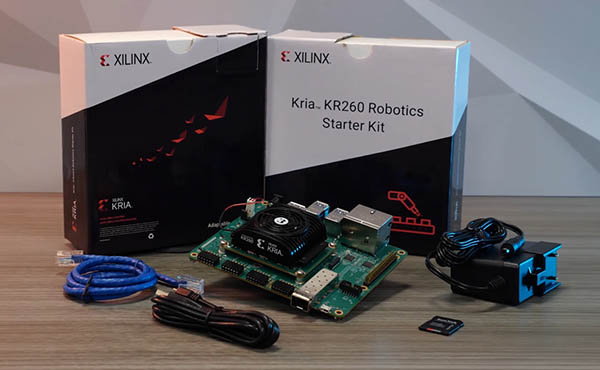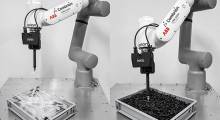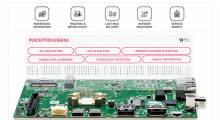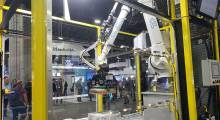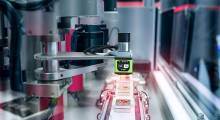Advanced Micro Devices Inc., or AMD, this week announced the Kria KR260 Robotics Starter Kit, the latest addition to its Kria line of developer kits and adaptive system-on-modules, or SOMs.
With native support for ROS 2, the open-source Robotics Operating System, and prebuilt interfaces, the new SOM kit enables rapid development of hardware-accelerated applications for robotics, machine vision, and industrial communication and control, said AMD.
“The Kria KR260 Robotics Starter Kits builds on the success of our Kria SOMs and KV260 Vision AI Starter Kit for AI and embedded developers, providing roboticists with a complete, out-of-the-box solution for this rapidly growing application space,” stated Chetan Khona, senior director of industrial, vision, healthcare, and sciences markets at AMD.
“Roboticists will now be able to work in their standard development environment on a platform that has all the interfaces and capabilities needed to be up and running in less than an hour,” Khona said. “The KR260 Starter Kit is an ideal platform to accelerate robotics innovation and easily take ideas to production at scale.”
AMD supports adaptive computing in robotics
For more than 50 years, AMD said it has driven innovation in high-performance computing, graphics, and visualization technologies. The Santa Clara, Calif.-based company said the Kria KR260 offers “a seamless path to production deployment with the existing Kria K26 adaptive SOMs.” It acquired adaptive computing company Xilinx in February.
AMD said it designed the Kria KR260 in response to customer reactions to its SOM product line.
“Since the launch of the portfolio, just a little over a year ago, we have seen tremendous interest in the product and are seeing deployments across the globe,” Khona told Robotics 24/7. “We’ve shipped a little over a 2:1 ratio in production SOMS versus kits to date, with the expectation that that grows significantly over time after the evaluations transition to production deployments.”
“A recent example comes from a winner in our Adaptive Computing Contest —the Kria Autonomous Robotics Platform (KARP),” he said. “The project makes use of different advanced technologies like AMD-Xilinx FPGAs [field-programmable gate arrays], Vitis AI 2.0, ROS 2, Odrive motor controller, Velodyne lidar, and more.”
“KARP is easily customizable depending on the application users want to give to this low-cost robotic platform,” said Khona. “The industry is seeing a huge growth in robotics and the diversity of use cases.”
In terms of safety and cybersecurity, KRS builds on AMD's functional safety assessments for ISO 13849, existing support for the XEN hypervisor, and IEC 62443, but not all capabilities are enabled at the time of launch.
AMD claims competitive advantage
The global market for robotics components could expand at a compound annual growth rate (CAGR) of 20.4% between 2019 and 2025, with revenues reaching about $126 billion in 2025, forecast Omdia. To use those components, robotics developers need tools to speed time to market, added AMD.
It claimed that the Kria KR260 is an end-to-end adaptive robotics platform that can deliver nearly a 5X productivity gain over competing NVIDIA gaphics processing unit (GPU)-based systems, such as Jetson AGX Xavier Developer Kit and Jetson Nano Developer Kit using Isaac ROS SDK 4.6.1.
AMD said it used the KV260 Starter Kit based on Kria K26 SOM, using Vitis Unified SW Platform 2021.2 and Kria Robotics Stack. Development time accounted for tool-chain setup with ROS 2, cross-compilation of host code, and creation of accelerators implementing two functions: doublevadd_publisher and accelerated_doublevadd_publisher.
“The Kria SOM portfolio accelerates the design cycle for developers by starting at a more evolved point compared to chip-down design,” said Khona. It typically offers up to a nine-month savings in time to deployment, and developers do not need FPGA expertise, he added.
The KR260's pre-built interfaces for robotics, combined with a growing list of applications delivered via the AMD-Xilinx App Store, enable easy evaluation and a seamless path to deployment, said the company.
Kria stack works with ROS 2
AMD said the Kria Robotics Stack (KRS) is an integrated set of libraries and utilities that use hardware to accelerate the development, maintenance, and commercialization of industrial-grade robots with Kria SOMs. It said the goal is to make adaptive computing more accessible to the robotics community.
The KR260 also includes support for the widely-adopted Ubuntu embedded operating system, providing compatibility with the latest long-term support (LTS) versions of Ubuntu Linux Desktop (22.04) from Canonical and ROS 2 Humble Hawksbill.
The low-latency, adaptive computing architecture of Kria SOMs, implemented with KRS and ROS 2, can deliver over 8X better performance per watt and up to 3.5X lower latency compared with GPU-based systems such as Jetson AGX Xavier and Jetson Nano, claimed AMD.
AMD said it is collaborating with Open Robotics, which creates open-source robotics software and hardware, to validate and ensure compliance of its ROS 2 implementation.
“The Kria SOM family and KR260 Starter Kit provide the robotics community with a great combination of performance, flexibility, and rapid development time,” said Brian Gerkey, CEO of Open Robotics. “Users can create software-defined hardware and build solutions offering high performance per watt, with security, energy efficiency, and adaptability.”
“Open Robotics is excited to be collaborating with AMD-Xilinx to understand and address the needs of roboticists using hardware acceleration to build new robot applications with the KR260 development platform,” he said.
Kria KR260 now available
The Kria KR260 Robotics Starter Kit is available for $349 from AMD and its worldwide network of distributors. With the Kria KV260 Vision AI Starter Kit, the KR260 provides an easy-to-use platform for designing vision applications, said the company.
“Price is definitely a differentiator, as some development kits can be about $2,000 and will be more expensive on the power/watt-per-cost metric,” said Khona. “Whereas Kria SOMs are well under the $500 range and are much better aligned with the power-per-watt, per cost metric for our embedded customers.”
AMD showed its Kria portfolio at the 2022 Embedded Vision Summit this week at the Santa Clara Convention Center. It also presented a session on “Introducing the Kria Robotics Starter Kit, Robotics, and Machine Vision for Smart Factories.”
Article topics
Email Sign Up

